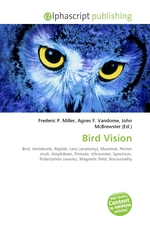Bird Vision
Frederic P. Miller, Agnes F. Vandome, John McBrewster
бумажная книга
Vision is the most important sense for birds, since good eyesight is essential for safe flight, and this group has a number of adaptations which give visual acuity superior to that of other vertebrate groups; a pigeon has been described as "two eyes with wings". The avian eye resembles that of a reptile, but has a better-positioned lens, a feature shared with mammals. Birds have the largest eyes relative to their size within the animal kingdom, and movement is consequently limited within the eye's bony socket. In addition to the two eyelids usually found in vertebrates, it is protected by a third transparent movable membrane. The eye's internal anatomy is similar to that of other vertebrates, but has a structure, the pecten oculi, unique to birds. Birds, like fish, amphibians and reptiles, have four types of colour receptors in the eye. Most mammals have two types of receptors, although primates have three. This gives birds the ability to perceive not just the visible range but also the ultraviolet part of the spectrum, and other adaptations allow for the detection of polarised light or magnetic fields.
Данное издание не является оригинальным. Книга печатается по технологии принт-он-деманд после получения заказа.


